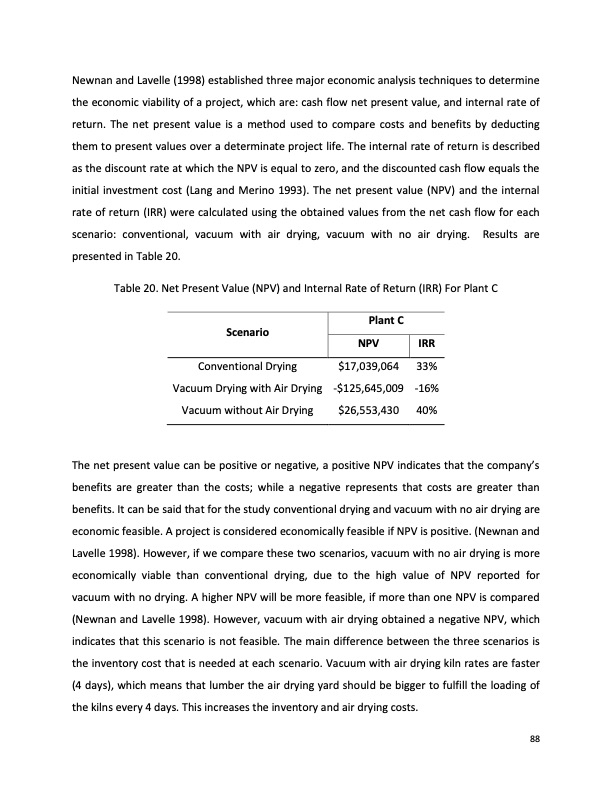
PDF Publication Title:
Text from PDF Page: 098
Newnan and Lavelle (1998) established three major economic analysis techniques to determine the economic viability of a project, which are: cash flow net present value, and internal rate of return. The net present value is a method used to compare costs and benefits by deducting them to present values over a determinate project life. The internal rate of return is described as the discount rate at which the NPV is equal to zero, and the discounted cash flow equals the initial investment cost (Lang and Merino 1993). The net present value (NPV) and the internal rate of return (IRR) were calculated using the obtained values from the net cash flow for each scenario: conventional, vacuum with air drying, vacuum with no air drying. Results are presented in Table 20. Table 20. Net Present Value (NPV) and Internal Rate of Return (IRR) For Plant C Scenario Conventional Drying Vacuum Drying with Air Drying Vacuum without Air Drying Plant C NPV IRR $17,039,064 33% -$125,645,009 -16% $26,553,430 40% The net present value can be positive or negative, a positive NPV indicates that the company’s benefits are greater than the costs; while a negative represents that costs are greater than benefits. It can be said that for the study conventional drying and vacuum with no air drying are economic feasible. A project is considered economically feasible if NPV is positive. (Newnan and Lavelle 1998). However, if we compare these two scenarios, vacuum with no air drying is more economically viable than conventional drying, due to the high value of NPV reported for vacuum with no drying. A higher NPV will be more feasible, if more than one NPV is compared (Newnan and Lavelle 1998). However, vacuum with air drying obtained a negative NPV, which indicates that this scenario is not feasible. The main difference between the three scenarios is the inventory cost that is needed at each scenario. Vacuum with air drying kiln rates are faster (4 days), which means that lumber the air drying yard should be bigger to fulfill the loading of the kilns every 4 days. This increases the inventory and air drying costs. 88PDF Image | Impact of Vacuum-Drying on Efficiency of Hardwood Products

PDF Search Title:
Impact of Vacuum-Drying on Efficiency of Hardwood ProductsOriginal File Name Searched:
Brenes_Angulo_OM_T_2014.pdfDIY PDF Search: Google It | Yahoo | Bing
5,000 BF Shipping Container Lumber Dry Kiln For Quality Lumber The 5,000 BF container kiln consists of one 40 foot high-cube aluminum shipping container... More Info
Shipping Container Lumber Dry Kilns by Global Energy Global Energy designed and developed the container kiln back in 1991. The purpose is to give access to portable sawmill owners, furniture makers, and small business the value added profit of dry kiln lumber and quality hardwoods... More Info
Vacuum Kiln Conversion Kit for Lumber and Wood Dry Kilns Convert your existing conventional dry kiln into a fast drying vacuum kiln. Similar to vacuum bagging in the boat building and aircraft industry, we have come up with a proprietary process which allows you to build a very simple vacuum kiln at a fraction of the price, and without the intensive conventional metal chamber structure... More Info
Vacuum Pump Cart System for Bagging Clamping Wood Drying and more Vacuum Cart with 2HP Pump and Dual Pistons with multiple multiplex vacuum ports and liquid reservoir... More Info
Vacuum Bagging Basics Vacuum bagging is a method of clamping, which has traditionally been used in the composites industry, but can also be used for vacuum drying materials, including wood products... More Info
| CONTACT TEL: 608-238-6001 Email: greg@globalmicroturbine.com | RSS | AMP |